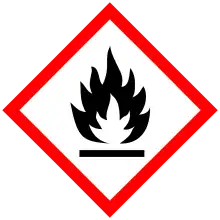| Names | |
|---|---|
| Preferred IUPAC name
1-(Butoxymethoxy)butane | |
| Other names
Butylal | |
| Identifiers | |
3D model (JSmol) |
|
| ChemSpider | |
| ECHA InfoCard | 100.018.100 |
| EC Number |
|
PubChem CID |
|
| UNII | |
CompTox Dashboard (EPA) |
|
| |
| |
| Properties | |
| C9H20O2 | |
| Molar mass | 160.257 g·mol−1 |
| Density | 0.838 |
| Boiling point | 179.2 °C (354.6 °F; 452.3 K) |
| insoluble | |
Refractive index (nD) |
1.406 |
| Hazards | |
| GHS labelling: | |
  | |
| Warning | |
| H226, H315, H412 | |
| P210, P233, P240, P241, P242, P243, P264, P273, P280, P302+P352, P303+P361+P353, P321, P332+P313, P362, P370+P378, P403+P235, P501 | |
Except where otherwise noted, data are given for materials in their standard state (at 25 °C [77 °F], 100 kPa).
Infobox references | |
Dibutoxymethane is an oligoether (more than one -O- grouping) or acetal containing two butyl groups and a methylene grouping.[1] It is used in cosmetics, as a cleansing agent, or solvent. It reduces the formation of soot and nitrogen oxides when added to diesel fuel.[2] It can be classed as a green solvent, as it contains no halogens, and is not very toxic.[3]
References
- ↑ "Dibutoxymethane". webbook.nist.gov.
- ↑ Delfort, B.; Durand, I.; Jaecker-Voirol, A.; Lacôme, T.; Paillé, F.; Montagne, X. (2002). "Oxygenated Compounds and Diesel Engine Pollutant Emissions Performances of New Generation of Products". SAE Transactions. 111: 1871–1880. ISSN 0096-736X. JSTOR 44734655.
- ↑ Spalding, Mark A.; Chatterjee, Ananda (2017). Handbook of Industrial Polyethylene and Technology: Definitive Guide to Manufacturing, Properties, Processing, Applications and Markets Set. John Wiley & Sons. p. 147,150. ISBN 978-1-119-15978-0.
This article is issued from Wikipedia. The text is licensed under Creative Commons - Attribution - Sharealike. Additional terms may apply for the media files.